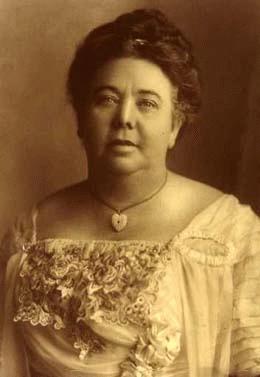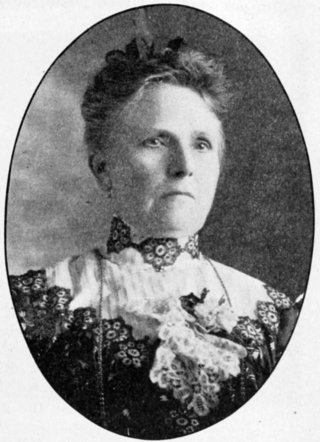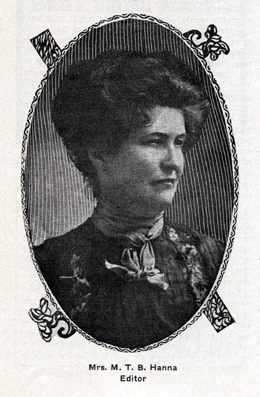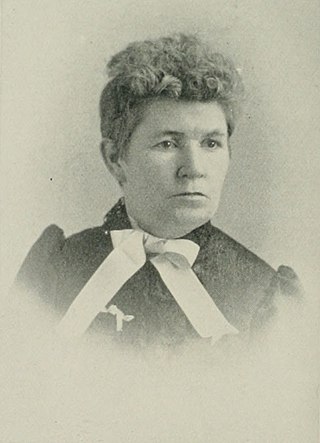
The New Northwest was an American weekly newspaper published in Portland, Oregon, from 1871 to 1887 by Abigail Scott Duniway, and for another two years by O. P. Mason. One of the first newspapers in the Western United States to champion the cause of women's rights, during its 16-year run, The New Northwest emerged as a vigorous voice for women's suffrage and for liberalization of marriage law and property rights for women. The newspaper's motto was Free Speech, Free Press, Free People.

Abigail Scott Duniway was an American women's rights advocate, newspaper editor and writer, whose efforts were instrumental in gaining voting rights for women.

May Arkwright Hutton was a suffrage leader and labor rights advocate in the early history of the Pacific Northwest of the United States.

The history of Washington includes thousands of years of Native American history before Europeans arrived and began to establish territorial claims. The region was part of Oregon Territory from 1848 to 1853, after which it was separated from Oregon and established as Washington Territory following the efforts at the Monticello Convention. On November 11, 1889, Washington became the 42nd state of the United States.
Daniel Bigelow was a pioneer lawyer and politician in Olympia, Washington.

Women's suffrage in Utah was first granted in 1870, in the pre-federal period, decades before statehood. Among all U.S. states, only Wyoming granted suffrage to women earlier than Utah. Because Utah held two elections before Wyoming, Utah women were the first women to cast ballots in the United States after the start of the suffrage movement. However, in 1887 the Edmunds–Tucker Act was passed by Congress in an effort to curtail Mormon influence in the territorial government, disallowing the enfranchisement of the women residents within Utah Territory.

Emma Smith DeVoe was an American women suffragist in the early twentieth century, changing the face of politics for both women and men alike. When she died, the Tacoma News Tribune called her Washington state's "Mother of Women's Suffrage".

Sara Bard Field was an American poet, suffragist, free love advocate, Georgist, and Christian socialist. She worked on successful campaigns for women's suffrage in Oregon and Nevada. Working with Alice Paul and the National Woman's Party at the 1915 Panama-Pacific International Exposition in San Francisco, Field drove across the country from California to Washington, D.C. to present a petition containing a reported 500,000 signatures demanding a federal suffrage amendment to President Woodrow Wilson. She was known as a skilled orator and became a poet later in her career, marrying her long-time partner and mentor, poet and lawyer C.E.S. Wood.

Cornelia Hatcher (1867–1953) was an American suffragist and temperance activist. In 2009, Hatcher was named to the Alaska Women's Hall of Fame.
This timeline highlights milestones in women's suffrage in the United States, particularly the right of women to vote in elections at federal and state levels.

Women's suffrage was established in the United States on a full or partial basis by various towns, counties, states and territories during the latter decades of the 19th century and early part of the 20th century. As women received the right to vote in some places, they began running for public office and gaining positions as school board members, county clerks, state legislators, judges, and, in the case of Jeannette Rankin, as a member of Congress.

Abbie Howard Hunt Stuart (1840–1902) was an American suffragist and founder of the Woman's Club of Olympia.

Catherine Amanda Coburn was an American pioneer of the long nineteenth century associated with the Oregon Territory. Entering the workforce after the untimely death of her husband, she became a teacher and school principal and, later, a newspaper editor. A century after her birth, she and her elder sister were described by an Oregon historian as "probably Oregon's two greatest women journalists." Coburn was active in civic life, especially in her later years. Though she did not identify as a "suffragette", she did actively support the cause of women's suffrage, among various charitable and civic causes.

Minnie Bronson was an American anti-suffragist activist who was general secretary of the National Association Opposed to Woman Suffrage.

Mary Elizabeth Ordway, an early advocate for women's suffrage in Washington territory, was one of the first group of young women recruited to become teachers and wives in pioneer Seattle in the 1860s. Despite the expectation that these "Mercer Girls" would marry, Ordway remained single and became a successful teacher, school administrator, and suffrage activist. The suffrage activism of Ordway and some of the other "Mercer Girls" reflected their educational levels, professional status, and the values associated with personal autonomy that promoted their decisions to migrate across the continent to build new lives.

Missouri T. B. Hanna (1857–1926), born Missouri Saunders, was an American suffragist, journalist, publisher and property developer from the state of Washington. She resided in Edmonds for most of her adult life.
Linda Deziah Jennings (1870-1932) was an American women's suffrage activist and cookbook editor, based in Washington state. She was the editor of Washington Women's Cook Book (1908), which was published by the Washington Equal Suffrage Association. The cookbook, which was a charity cookbook, served as a fundraiser for the group and helped to bring the cause of suffrage into Washington homes.

Lucy Switzer was an American temperance and suffrage activist. She wrote many articles for Pacific Christian Advocate and the Christian Herald, and was a columnist in Cheney, Spokane County, Washington. She established the women's suffrage movement in eastern Washington Territory.
Mary Anna Cooke Thompson was a leader in the first generation of women's rights activists in Oregon and one of Oregon's pioneer doctors, who broke through the barriers to women in medicine.
Lucie Fulton Isaacs was an American writer, philanthropist, and pioneer suffragist. As a writer of essays and descriptive articles, she was known to early readers of the Overland magazine and other western periodicals under various pen names, suffering from shyness that made her shrink from publicity. She was a co-organizer of the first woman's club in Walla Walla, Washington, a member of the Oregon Pioneer Association, and a supporter of the arts. Isaacs served as president of Walla Walla's suffrage association, lived to see full suffrage given to women, and voted before her death in Walla Walla, November 1916.















